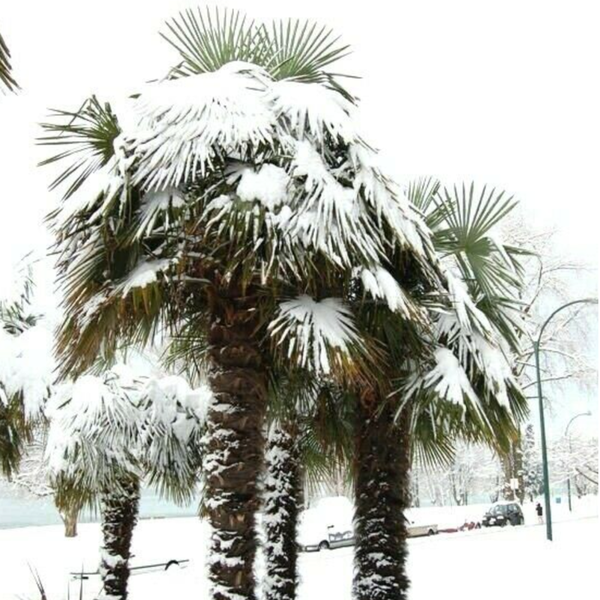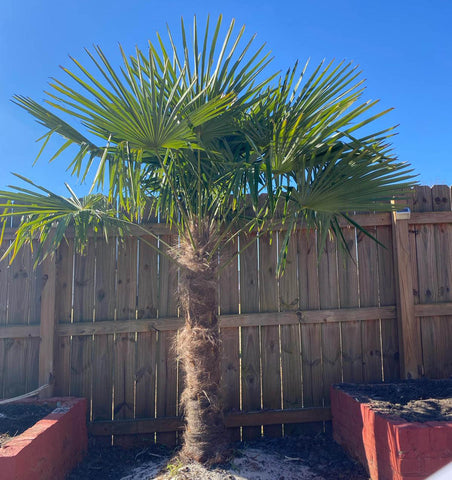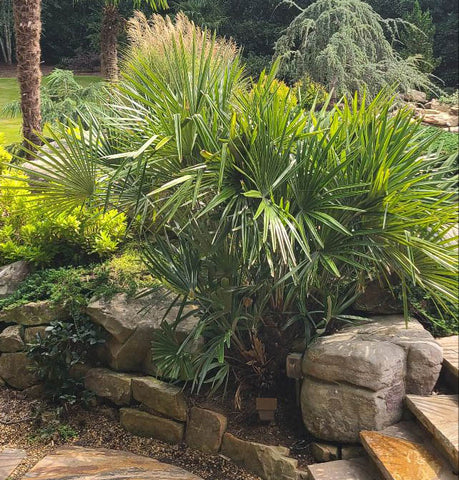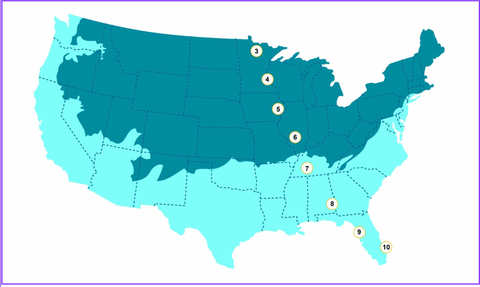
When you imagine paradise, it is often a vision of sandy beaches, tropical warmth, and iconic lush palm trees. Palms unquestionably evoke images of paradise, but they can go beyond hot climates. Many palm species have evolved the capacity to not only survive but flourish in colder climates.
Not all cold hardy palms thrive under the same conditions, so it is crucial to consider specific factors when planting them in colder climates:
- Hardiness Zone- Choose plants and palms appropriate for your growth zone and consider the minimum temperatures experienced in recent winters in your area.
- Cold Tolerance vs Sustained Cold Tolerance- Ensure that your palm not only matches the lowest winter temperatures at your location but that it also has a sustained cold tolerance. Tolerating a short drop at minimum temperature is one matter; enduring weeks under such conditions is another entirely.
- Windchill- Evaluate whether the palm is sheltered, surrounded by trees or shrubs as protection or if it is exposed and taking the wind straight on. Less windchill on your palms means less frond damage.
- Root Hardiness- Most cold hardy palms have roots adapted to endure frigid temperatures. Mulching around the palm can help insulate the roots to keep them warmer.
- Precipitation- Consider the amount of winter rainfall in your area, as excessive rain combined with freezing temperatures can damage fronds. Keep in mind that the growth of most cold hardy palms is slow, so any cold damage to fronds may take time to remedy.
- Maturity- The maturity of the palm can also affect how cold hardy it is. Younger palms are more tender, and might need a little protection to increase their survival rates. More established palms are hardier, as they have had time to adapt to their environment.
- Time- Two years is the sweet spot with palms and cold hardiness. Once a palm makes it through two winters, it is as cold hardy as it will ever be.
These factors are crucial for determining the true cold hardiness of palms, and can help us distinguish between cold hardy and SUPER cold hardy palms. While a cold hardy palm may survive a tough winter at its minimum tolerated temperature, SUPER cold hardy palms will not only survive but also look amazing through the process.
At Atlanta Palms, we've curated a SUPER Cold Hardy collection featuring three palms: Windmill Palm, Dwarf Palmetto, and Needle Palm. These palms stand out as the hardiest among all the cold hardy varieties we offer, demonstrating remarkable resilience against sustained temperature drops and windchill, all while looking stunning.

Super cold hardy palm #1
Windmill Palm
The Windmill Palm is the tallest of all cold hardy palms, boasting fan-shaped fronds that form an evergreen canopy atop a single slender trunk, giving it the classic palm appearance. Cold hardy and tough, it will stand tall and strong in your yard and look amazing through the seasons.

The Windmill palm thrives in a variety of well drained soils and weather, making it the perfect palm for those seeking tall looking and low maintenance cold hardy palms.
- Grow Zone: 7a-11
- Minimum Temp: 5°F with drops to 0°F
- Mature Height:18-25 ft in USDA zone 7a-8
- Growth Rate: 5" per year
- Sunlight: Full sun to partial shade
Best Landscape Uses for the Windmill Palm:
As a standalone palm, as part of as a group in staggered heights, or as a palm row lining an entrance.
Super cold hardy palm #2
Dwarf Palmetto (Sabal Minor)

The Dwarf Palmetto, also known as the Sabal Minor, is a graceful shorter palm with upright evergreen fan-like fronds emerging from a single base. It resembles a young Sabal Palmetto, (which is where it gets its name), and is a wow factor in any yard as a stand-alone palm, with its upright fan fronds, or as well as a complementing element under a taller tree or palm.
It grows in any well drained soil, and can be planted in all sorts of grounds- even steep and sloped terrains.
- Grow Zone: 7a-11
- Minimum Temp: 5° F with drops to 0°F
- Mature Height: 3-5 ft in USDA zone 7a-8
- Growth Rate: 5" per year
- Sunlight: Full sun to partial shade.
Best Landscape Uses for the Dwarf Palmetto Palm:
Perfect as a short focal element or in a row lining a fence.
Super cold hardy palm #3
Needle Palm
Needle Palms are slow growing, glossy-green palms that require minimal maintenance and are adaptable to various conditions. They are not only exceptionally cold hardy (the cold hardiest of the world), they are one of the few palms that tolerate having their roots be constantly wet, making them perfect near pools or bodies of water.

Needle Palms have a clumping habit, and give any area a bushy and lush look-fantastic year round greenery!
- Grow Zone: 6b-11
- Minimum Temp: 0° F with drops to -5°F
- Mature Height: 4-56 ft in USDA zone 6b-8
- Growth Rate: 5" per year
- Sunlight: Full sun to partial shade.
Best Landscape Uses for the Needle Palm Tree:
Near a pool, as a companion plant for taller trees.
Some thoughts on Super Cold-hardy palms
The Windmill Palm, Needle Palm and Dwarf Palmetto are the strongest, most cold hardy palms we could find. They stand as resilient symbols of nature´s adaptability, thriving in cold climates with minimal care-and looking good while doing it! Their evergreen beauty and hardiness make them ideal choices for creating tropical oases when weather gets cooler. Add these palm
Cold Hardy palms in my areaSuper cold hardy palms thrive in zone 7-11, opening up the possibility for a significant portion of the United States to have outdoor palms. States that may have previously thought were too cold for palms can include these Super cold hardy palms in their yards!
Cities that fall into this area are places where you would not typically consider having palm trees, such as Nashville,TN, Long Island NY, Oklahoma City, or Seattle, WA to name a few. Zone 7 includes: Long Island, western South Carolina, southern Tennessee, North Georgia, North Alabama and North Mississippi along with a big chunk of Arkansas, Oklahoma, a part of Northern Texas, southern New Mexico, central Arizona, southern Utah, and southern and western parts of Nevada as well as eastern California. This encompasses more than 20 states where Super cold hardy palms can easily grow in yards.

Check and see what grow zone you are in, and buy your SUPER Cold Hardy Palms from Atlanta Palms, lots of sizes available!

